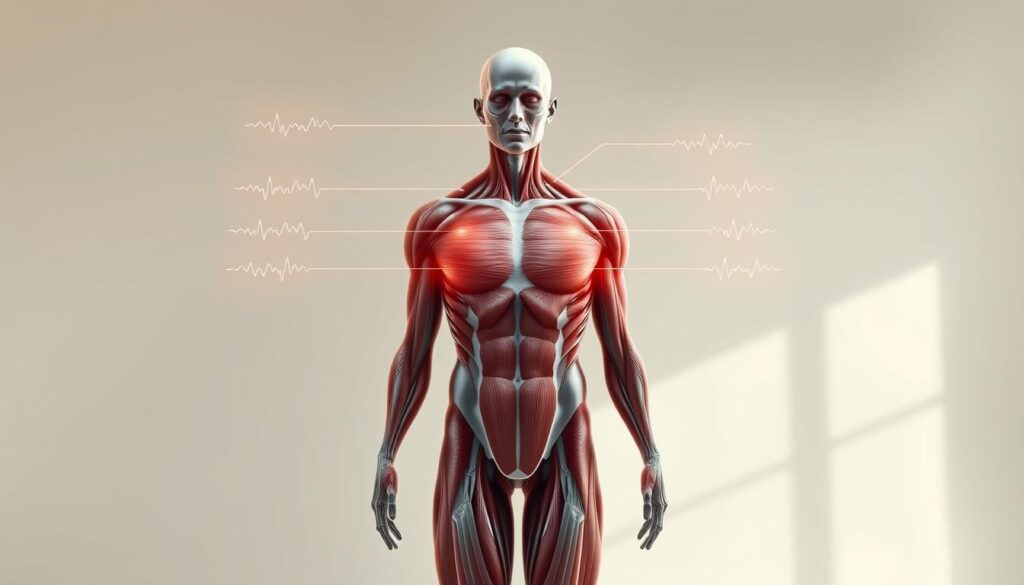Did you know that your muscles are constantly sending signals about your health? Research shows that muscle testing, also known as Applied Kinesiology, is increasingly used by chiropractors and functional medicine practitioners as a diagnostic tool1. This method is based on the principle that muscles are connected to specific organs and systems through the nervous system. For instance, weakness in a muscle during testing may indicate an issue related to the corresponding organ or system1.
Chiropractors and functional medicine experts use muscle testing to uncover underlying health issues. For example, Dr. Case demonstrates how muscle testing can detect a leaky gut, often caused by antibiotics, medication, or certain foods1. In one case, muscle testing revealed a patient’s sensitivity to milk, highlighting how this method can pinpoint specific food issues1.
This article explores how your body communicates through muscle signals, connecting them to your overall health. You’ll learn how your brain and body work together through these messages, offering insights into neurology, exercise, and recovery.
Key Takeaways
- Muscles communicate health issues through signals connected to organs and systems.
- Muscle testing is a diagnostic tool used in chiropractic and functional medicine.
- Muscle weakness may indicate specific organ or system issues.
- Food sensitivities can be identified through muscle testing.
- Understanding muscle signals enhances overall health and well-being.
Introduction to Decoding Your Body’s Signals
Your body is constantly communicating with you through muscle signals, offering insights into your health and well-being. These signals can reveal stress, injury, or even nutritional deficits, acting as an early warning system2.
Overview of Muscle Communication
Muscles play a vital role in movement and daily activities. There are different types of muscles, each contributing uniquely to your body’s function. Voluntary muscles, like those in your arms and legs, are under your control, while involuntary muscles, such as those in your digestive tract, operate automatically3.
When muscles communicate, they send signals through the nervous system. For example, muscle tension might indicate stress, while weakness could signal a nutritional deficiency. Understanding these signals helps you address issues before they escalate2.
Importance of Listening to Your Muscles
Paying attention to your muscles is crucial for maintaining health. Ignoring signals like pain or fatigue can lead to more severe problems. By listening to your body, you can take proactive steps to prevent injuries and improve overall well-being3.
- Muscles provide vital information about internal conditions.
- They signal stress, injury, or nutritional needs.
- Different muscle types aid in movement and daily tasks.
- Listening to your muscles offers early warnings for health issues.
- Both voluntary and involuntary muscles contribute to bodily health.
- Muscle communication guides practical exercise and recovery advice.
By understanding and responding to your muscles’ signals, you can enhance your exercise routines and recovery processes. This connection is key to optimizing your health and ensuring your body functions at its best.
8. The Hidden Language of Muscles: What Your Body is Trying to Tell You
Your muscles are more than just movement-makers—they’re messengers. They communicate with your brain and the rest of your body through a complex network, sending signals that can reveal underlying health issues. This silent dialogue is a key part of functional medicine, helping practitioners uncover imbalances that might not be visible on the surface4.
Key Concepts Behind Muscle Messaging
The connection between muscles and organs is rooted in the nervous system. When a muscle weakens during testing, it may signal a problem in the linked organ or system. For example, a weak quadriceps muscle could indicate issues with the liver or adrenal glands4. This relationship is a cornerstone of Applied Kinesiology, a method used by chiropractors and functional medicine experts to diagnose and treat health issues.
Practical Implications for Your Health
Muscle testing can reveal food sensitivities, like lactose intolerance, by observing muscle weakness when certain foods are introduced4. It can also detect structural misalignments, such as a tilted pelvis, which might cause lower back pain. By addressing these issues early, you can prevent chronic problems and improve your overall well-being.
Understanding muscle signals is like having a personal health guide. It helps you make informed decisions about diet, exercise, and stress management, ensuring your body functions at its best.
How Muscle Testing Unveils Hidden Health Clues
Muscle testing is a powerful diagnostic tool that reveals insights into your health by assessing muscle strength and resistance. Originating from Applied Kinesiology, this method has been refined over decades to provide a non-invasive way to identify imbalances in your body’s systems5.
What is Muscle Testing?
Muscle testing involves applying gentle pressure to specific muscles to evaluate their strength and resistance. This technique, developed by Dr. George Goodheart in 1964, is now a cornerstone in functional medicine5. Over 250 specific muscle tests have been identified, each linked to particular organs and systems, allowing practitioners to pinpoint issues that traditional exams might overlook5.
The Science Behind Muscle Signals
The science behind muscle testing lies in the connection between muscles and the nervous system. When a muscle weakens during testing, it may indicate an imbalance in the corresponding organ or system. For example, a weak quadriceps muscle could signal issues with the liver or adrenal glands5. This method is particularly effective in detecting food sensitivities and structural misalignments, offering early detection of potential health issues5.
By understanding these muscle signals, practitioners can develop personalized treatment plans, addressing issues before they escalate. This approach emphasizes the body’s innate healing abilities, integrating holistic methods for optimal health outcomes5.
The Role of Functional Medicine in Muscle Health
Functional medicine plays a pivotal role in understanding muscle health by adopting an integrative approach. This method evaluates how your muscles function within the context of your entire body, rather than viewing them in isolation. By focusing on the interconnectedness of muscle function, organ health, and overall well-being, functional medicine offers a holistic perspective that traditional practices might overlook.
Chiropractic Perspectives on Muscle Function
Chiropractors often use muscle testing to identify relationships between muscles and organs. This technique helps determine if a weak muscle might signal an issue with a corresponding organ. For instance, a weak quadriceps muscle could indicate problems with the liver or adrenal glands6. Such insights allow chiropractors to address health issues at their root, promoting comprehensive care.
Applied Kinesiology in Practice
Applied kinesiology is a cornerstone of functional medicine, used to diagnose and treat imbalances. It involves gentle pressure on specific muscles to assess strength and resistance. This method, developed by Dr. George Goodheart, has over 250 identified tests, each linked to particular organs and systems6. For example, muscle testing can reveal food sensitivities, such as lactose intolerance, by observing weakness when certain foods are introduced6.
By understanding muscle signals, practitioners can create personalized care plans. This approach emphasizes the body’s innate healing abilities, integrating holistic methods for optimal health outcomes. Whether addressing digestive issues or structural misalignments, functional medicine and chiropractic care offer a pathway to enhanced well-being through muscle health.
Understanding the Body’s Internal Communication System
Your body operates like a finely tuned network, with organs, muscles, and the nervous system working together to maintain balance. This complex communication ensures that your body functions smoothly, from regulating energy levels to responding to external stimuli. The central nervous system plays a key role in this process, acting as a messenger between muscles and organs7.
When your muscles tense up, it might signal stress or an underlying condition. This connection is part of a larger dialogue where the nervous system interprets signals from muscles to assess organ health. For instance, muscle weakness during testing can indicate issues with the liver or adrenal glands7. Conditions like leaky gut or inflammation can disrupt this communication, leading to missignals that affect overall well-being.
Early detection of these communication breakdowns is crucial. Muscle testing can reveal misalignments or sensitivities, helping to address issues before they become chronic. By listening to your body‘s signals, you can take proactive steps to restore balance and support long-term health8.
Connecting Muscle Function to Vital Health Indicators
Your muscles are intricately linked to your overall health, acting as indicators of organ function and circulatory efficiency. This connection is vital for maintaining balance and detecting potential issues early. For instance, the strength of specific muscles can signal the health of related organs, while muscle imbalances might indicate problems with blood flow or organ function9.
Muscle and Organ Relationships
Muscles are connected to organs through the nervous system, and their strength can reflect organ health. For example, weakness in the quadriceps might suggest issues with the liver or adrenal glands9. Similarly, the erector spinae muscles contribute significantly to back stability, with over 50% of the force needed for back extension coming from these muscles10.
Muscle imbalances can signal underlying health concerns. Weakness in certain areas might indicate poor blood flow or organ dysfunction. For instance, a weak muscle in the abdominal region could point to digestive issues. Monitoring these relationships helps you understand your health better and take proactive steps9.
- Muscle strength directly connects to specific organ functions, offering insights into health status.
- Imbalances can signal blood flow issues or organ dysfunction, highlighting the need for early intervention.
- Examples include the quadriceps-liver connection and erector spinae’s role in back stability.
- Regular monitoring of these relationships provides a clearer picture of overall health.
- Targeted training can help rebalance muscle-organ connections, improving well-being.
- Regular assessments are crucial for maintaining optimal health indicators and preventing chronic issues.
By understanding and addressing these connections, you can enhance your health through informed decisions and targeted interventions. Regular assessments and focused training play key roles in maintaining balance and overall well-being9.
The Power of Exercise: Movement, Recovery, and Muscle Vitality
Exercise is a cornerstone of health, playing a vital role in muscle vitality and overall well-being. Regular physical activity not only strengthens muscles but also enhances cardiovascular health and boosts energy levels. By incorporating effective exercise techniques and proper recovery strategies, you can optimize your muscle function and maintain long-term health.
Effective Exercise Techniques
Movement is essential for muscle function and training outcomes. Engaging in at least 150 minutes of moderate exercise per week is recommended for optimal health11. Resistance training, particularly beneficial for adults over 50, can prevent falls and increase muscle mass11. Examples of effective routines include combining strength exercises with cardiovascular activities, such as cycling or swimming, to improve both muscle strength and heart health.
- Incorporate resistance training to build muscle and prevent falls.
- Aim for at least 150 minutes of moderate exercise weekly.
- Combine strength exercises with cardio for balanced fitness.
Recovery Strategies to Support Muscle Health
Recovery is crucial for muscle health and overall vitality. Cooldowns and stretching after workouts can prevent injury and enhance flexibility. Proper hydration and adequate rest are also essential for muscle repair and growth. Additionally, brief physical therapy exercises can support recovery and maintain muscle balance.
- Include cooldowns and stretching in your post-exercise routine.
- Stay hydrated and ensure sufficient rest for muscle repair.
- Incorporate physical therapy exercises for recovery support.
By integrating effective exercise techniques and proper recovery strategies, you can maintain muscle vitality and support overall health. This balanced approach ensures sustainable fitness and well-being.
Nutritional Influences on Muscle Efficiency and Health
Nutrition plays a crucial role in optimizing muscle function and overall health. The food you consume directly impacts your muscle performance, recovery, and energy levels. A well-balanced diet provides the necessary nutrients for muscle repair and growth, ensuring your body functions at its best.
Dietary Choices and Muscle Performance
Dietary choices significantly influence muscle efficiency. Consuming adequate protein is essential for muscle repair and growth. Research indicates that higher protein intake can reduce body weight and enhance body composition by decreasing fat mass while preserving fat-free mass12. For example, studies suggest that women should aim for 20 grams of protein per meal, while men require around 30 grams12.
Dietary fiber is another critical component of a muscle-friendly diet. Fiber aids in digestion and maintains steady energy levels, which is vital for muscle function. A diet rich in whole grains, fruits, and vegetables ensures sustained energy, reducing the likelihood of fatigue during training.
| Nutrient | Recommended Intake | Benefits |
|---|---|---|
| Protein | 20-30 grams per meal | Supports muscle repair and growth |
| Fiber | 25-30 grams daily | Enhances digestion and energy levels |
| Carbohydrates | 45-65% of total calories | Provides energy for muscle activity |
Food intake also affects weight management, which is closely linked to muscle health. Excess weight can strain muscles, particularly during physical activity. A balanced diet that includes lean proteins, vegetables, and whole grains helps maintain a healthy weight, supporting muscle efficiency and overall well-being.
Even minor adjustments to your diet can yield significant benefits. For instance, increasing your protein intake or adding more fiber to your meals can improve muscle function and reduce fatigue. These changes can enhance your exercise performance and contribute to long-term health.
In conclusion, a proactive approach to nutrition is vital for optimizing muscle efficiency and health. By focusing on balanced meals, adequate protein, and sufficient fiber, you can support your muscle function, enhance recovery, and maintain overall well-being.
Managing Stress and Inflammation for Optimal Muscle Function
Stress and inflammation are silent adversaries that can significantly impact your muscle health. Both physical and chemical stressors can lead to muscle tension and pain, while chronic inflammation can impair recovery and overall well-being. Recognizing the signals your body sends is crucial for maintaining optimal muscle function and preventing long-term damage.
Stress Triggers and Muscle Tension
Stress triggers can arise from various sources, including poor nutrition, inadequate rest, and emotional strain. These stressors cause muscle tension, which may lead to pain and discomfort. For example, a weak muscle during testing might indicate stress-related issues, as noted in studies13. Additionally, beliefs about pain play a significant role in how long it lasts and the level of disability experienced13.
- Physical stressors like lack of sleep can cause muscle tightness.
- Chemical stressors, such as poor diet, can lead to inflammation.
- Emotional stress can trigger muscle tension and pain.
Inflammation as a Health Signal
Inflammation is your body’s way of signaling potential health issues. Chronic inflammation can impair muscle recovery and lead to persistent pain. For instance, studies show that unhelpful beliefs about pain can prolong disability and worsen symptoms13.
- Chronic inflammation slows down muscle repair.
- Persistent pain and fatigue are common symptoms of inflammation.
- Healthcare professionals use muscle testing to detect stress-related symptoms.
Practical methods to manage stress include meditation, proper exercise routines, and mindfulness practices. These techniques can help reduce muscle tension and inflammation, promoting faster recovery and better health outcomes. Recognizing early symptoms is key to addressing issues before they escalate.

Integrating Muscle Testing into Your Wellness Routine
Muscle testing is a powerful tool for gaining real-time insights into your health. By incorporating this practice into your daily routine, you can uncover hidden imbalances and take proactive steps toward wellness. Chiropractors often use muscle testing to identify issues early, emphasizing a holistic approach to health14.
Practical Tips for At-Home Testing
Performing simple muscle tests at home can be straightforward. Start by selecting a muscle group, like the quadriceps, and have a partner gently apply pressure while you resist. This can help assess strength and detect weaknesses that may indicate underlying issues14.
- Choose a quiet, comfortable space for testing.
- Use a partner or self-test techniques for accuracy.
- Record results to track changes over time.
Regular testing can reveal potential health issues before they become severe. It fits seamlessly into a wellness plan, offering a clear connection between muscle function and overall well-being. This practice not only enhances physical health but also strengthens the communication between your brain and body14.
By making muscle testing a part of your routine, you gain valuable insights into your health. If you notice consistent weaknesses, consulting a professional can provide personalized solutions. This approach ensures you address issues early, promoting long-term wellness and vitality.
The Connection Between Brain, Muscle, and Pain Perception
Your brain, muscles, and pain perception are deeply interconnected, forming a complex communication network that influences your overall well-being. This system not only affects how you move but also how you experience pain. Understanding this connection can empower you to make informed decisions about your health.
Neurological Pathways of Muscle Communication
The brain processes sensory inputs from muscles through specific neurological pathways. These pathways enable the brain to interpret muscle signals, which can indicate pain, fatigue, or discomfort. For instance, when a muscle is injured, pain signals are transmitted to the brain, triggering a response to protect the affected area15.
- Sensory nerves detect muscle tension and pain.
- Signals are transmitted to the brain for interpretation.
- Pain and movement are closely linked through these pathways.
Cognitive Impact on Pain and Movement
Cognitive factors, such as stress and past experiences, significantly influence pain perception. Stress can heighten sensitivity to pain, while positive experiences may reduce it. For example, mindfulness practices have been shown to alter pain perception by changing how the brain processes signals16.
- Stress increases muscle tension and pain sensitivity.
- Targeted movement drills can retrain the brain to reduce pain.
- Mindfulness practices improve emotional regulation and pain management.
By understanding the connection between your brain, muscles, and pain perception, you can adopt strategies to enhance movement and reduce pain. This balanced approach not only improves physical health but also supports emotional well-being15.
Customizing Your Health Plan Based on Muscle Communication
Your brain, muscles, and body form a dynamic communication network that can guide you in creating a personalized health plan. By listening to your muscle signals, you can uncover insights that help tailor your exercise, diet, and recovery routines for optimal well-being.
Personalized Strategies for Better Health
Translating muscle testing results into actionable strategies is key to a customized health plan. For instance, if muscle testing reveals weakness in your quadriceps, it might indicate issues with your liver or adrenal glands17. This insight allows you to adjust your diet, incorporating foods that support liver health while avoiding triggers. Similarly, if testing shows sensitivity to certain foods, you can modify your meals to eliminate those items, potentially reducing inflammation and pain.
Exercise routines can also be tailored based on muscle communication. If your hamstrings are tight, focusing on stretching and strengthening exercises for that area can improve flexibility and reduce discomfort. Incorporating resistance training not only builds muscle strength but also supports overall muscle-organ connections, enhancing your body’s functionality.
Monitoring Your Progress Over Time
Regular muscle testing and physical assessments are essential for tracking progress. By repeating tests periodically, you can identify improvements or new areas of concern. For example, if a previously weak muscle shows increased strength, it may indicate that your dietary changes are positively impacting the corresponding organ17.
It’s important to seek professional guidance if you notice consistent muscle weaknesses or pain. A healthcare provider can offer personalized recommendations and treatments, ensuring you address issues before they escalate. They can also help integrate adaptive training into your routine, which is crucial for improving muscle strength and overall health over time.

By creating a customized health plan that adapts to your unique muscle signals, you can achieve measurable improvements in strength, energy, and well-being. This proactive approach ensures you’re always taking the right steps toward a healthier, more balanced life.
Conclusion
Understanding the intricate communication between your muscles, organs, and nervous system can revolutionize your approach to health. By listening to these internal signals, you gain insights into potential issues before they escalate. Muscle testing, for instance, has emerged as a powerful tool for detecting hidden imbalances, from food sensitivities to organ dysfunction18.
Exercise and nutrition play pivotal roles in maintaining muscle health. Regular physical activity, such as resistance training, not only strengthens muscles but also supports organ function19. A balanced diet rich in protein and fiber ensures optimal muscle repair and energy levels, which are essential for overall well-being20.
Stress and inflammation are silent adversaries that can disrupt muscle function and recovery. Practices like mindfulness and proper recovery strategies can help mitigate these effects, promoting faster healing and better health outcomes18.
In conclusion, by integrating muscle testing, tailored exercise routines, and nutritional insights, you can create a personalized health plan that addresses your unique needs. Paying attention to subtle bodily indicators allows for early intervention, enhancing your ability to prevent chronic issues and improve your quality of life. Remember, every part of your body communicates unique information—listening to these signals can lead to significant improvements in your overall well-being18.
FAQ
How does blood flow impact muscle health?
What role does fiber play in muscle function?
How does the human body use muscles to maintain balance?
Can hand exercises improve overall muscle strength?
How does injury affect muscle ability?
Source Links
- Muscle Testing: Revealing the Body’s Hidden Language | Morris Spine & Sport – https://www.morrisspineandsport.com/muscle-testing-revealing-the-bodys-hidden-language/
- Interoception 301 Activity Guide – https://www.education.sa.gov.au/docs/support-and-inclusion/student,-health-and-disability-support/interoception-301-activity-guide.pdf
- Body language – https://en.wikipedia.org/wiki/Body_language
- What Does Your Body Language Say? – https://www.webmd.com/sex-relationships/ss/slideshow-body-language
- Your Body Can Talk, Revised 2nd Edition by Susan Levy, D.C. (Ebook) – Read free for 30 days – https://www.everand.com/book/266936529/Your-Body-Can-Talk-Revised-2nd-Edition-Your-Body-Can-Talk-How-to-Use-Simple-Muscle-Testing-for-Health-and-Well-Being
- Approaches to Assessment of Muscle Mass and Myosteatosis on Computed Tomography: A Systematic Review – https://pmc.ncbi.nlm.nih.gov/articles/PMC7357454/
- Interoception and Mental Health: A Roadmap – https://pmc.ncbi.nlm.nih.gov/articles/PMC6054486/
- The silent “sixth” sense – https://www.vox.com/the-highlight/2019/11/22/20920762/proprioception-sixth-sense
- Human muscle system | Functions, Diagram, & Facts | Britannica – https://www.britannica.com/science/human-muscle-system
- 8. [Muscular System] | Anatomy & Physiology | Educator.com – https://www.educator.com/biology/anatomy-physiology/cardella/muscular-system.php
- 10 Things Your Doctor Wishes You’d Start Doing in Your 50s | PNI – https://www.pacificneuroscienceinstitute.org/blog/lifestyle/10-things-your-doctor-wishes-youd-start-doing-in-your-50s/
- Are you struggling with low energy, mood swings, or constant hunger? Discover how optimizing your fat intake can transform your health journey. – https://bodynetwork.com/8-warning-signs-your-body-needs-more-fat/
- Beliefs about the body and pain: the critical role in musculoskeletal pain management – https://pmc.ncbi.nlm.nih.gov/articles/PMC7817871/
- What is Kinesiology? – https://www.brisbanelivewellclinic.com.au/what-is-kinesiology-2/
- Interoception: the hidden sense that shapes wellbeing – https://www.theguardian.com/science/2021/aug/15/the-hidden-sense-shaping-your-wellbeing-interoception
- Explicit and Implicit Own’s Body and Space Perception in Painful Musculoskeletal Disorders and Rheumatic Diseases: A Systematic Scoping Review – https://pmc.ncbi.nlm.nih.gov/articles/PMC7161420/
- When Your Doctor “Gets It” and “Gets You”: The Critical Role of Competence and Warmth in the Patient–Provider Interaction – https://pmc.ncbi.nlm.nih.gov/articles/PMC6619399/
- Structure, function, and control of the human musculoskeletal network – https://pmc.ncbi.nlm.nih.gov/articles/PMC5773011/
- Building muscle with exercise: How muscle builds, routines, and diet – https://www.medicalnewstoday.com/articles/319151
- What Your Body Language Says About Your Relationship – https://www.marriage.com/advice/relationship/what-your-body-language-says-about-your-relationship/




